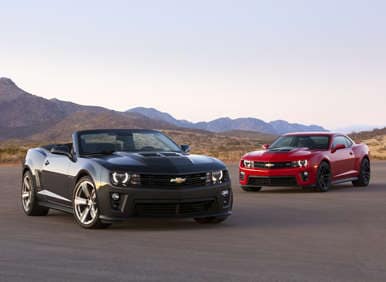Recent Articles
Popular Makes
Body Types
Chevrolet Camaro Used Car Buying Guide
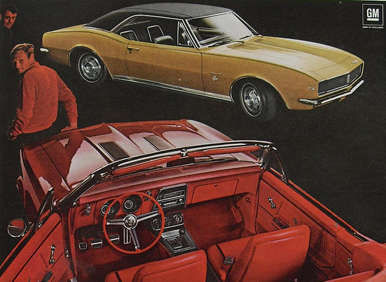
As one of the charter members of the American pony car club, the Chevrolet Camaro enjoys a significant place in American automotive history.
Announced to the world on June 28, 1966, the press conference heralding the launch of the Camaro marked the first time in history14 cities were hooked up in real-time via telephone lines. The actual car was shown for the first time was on September 12, 1966 at a press preview in Detroit. The Camaro officially went on sale September 9, 1966, as a1967 model.
Introduced specifically to compete with the Ford Mustang, at the press preview, when automotive writers asked where the name “Camaro” came from, or what the word “Camaro” meant, they were told a Camaro is a small vicious animal that eats Mustangs.
Undeniably a performance car, the Camaro has also always been offered with a smaller V6 engine, in addition to its larger V8. The Camaro has also always been offered in both coupe and convertible formats. Over the years, there have been a number of legendary Camaro performance models, the most famous being designated Z-28, SS, and ZL1. While these Camaros have attracted all of the attention and solidly suspended a halo firmly above the Chevrolet, the six-cylinder models have really carried the nameplate in terms of sales.
From the beginning, the very epitome of a teenager’s dream car, the Camaro enjoyed four generations of continuous production between its launch in 1967 and the end of the fourth generation Camaro's run in 2002. The model then went into hiatus for eight years—before the fifth-generation Chevrolet Camaro went on sale in the spring of 2009 for the 2010 model year.
This article will focus on the latter part of the run of the fourth generation and the fifth generation cars.
Chevrolet Camaro Used Car Buying Guide: 2000/2001/2002
By model year 2000, the Camaro had evolved significantly. And while the basic formula was still the same, the car had grown considerably in length. Of course, it had also grown more powerful over the years as technology improved. For model year 2000, the Camaro was available in both coupe and convertible body styles. Offered in three trim levels, there was a base model, a Z28, and the Z28 SS.
The base Camaro coupe was powered by a 200-horsepower, 3.8-liter V6, producing 225 foot-pounds of torque on regular fuel. A five-speed manual transmission was standard equipment and routed power to the rear wheels. A four-speed automatic was optional.
Standard features included bucket seats, a center console, power brakes, tinted glass, sixteen-inch wheels, ABS, driver and front passenger airbags, cloth upholstery, power steering, a tilt steering wheel, and air-conditioning. Other standard features included intermittent windshield wipers, automatic headlights, daytime running lights, an AM/FM cassette audio system, and a rear spoiler.
Options included an antitheft alarm system, audio controls for the steering wheel, cruise control, power windows, leather seats, remote trunk release, and leather steering wheel trim. The model could also be ordered with a CD changer, fog lights and glass T-tops. Other optional features included a ground effects aerodynamics kit, a keyless entry system, a lighted entry system, a limited slip differential, rear window defroster, and an AM/FM CD-based audio system. Base Camaro buyers could also get power door locks, a power driver's seat, and power exterior mirrors.
The base Camaro convertible’s standard equipment list was largely the same as the base Camaro coupe. However, it also included a leather shift knob and a leather steering wheel cover—in addition to keyless entry, fog lights, power door locks, and power mirrors.
The model year 2000 Chevrolet Camaro Z28 was powered by a 305-horsepower, 5.7 L V8 producing 335 foot-pounds of torque. It too, ran on regular unleaded fuel. Save the more powerful engine, its feature set was largely the same as the base Camaro. However, rather than a five-speed manual transmission, the Z28 used a six-speed manual transmission. It also offered the option of a leather shift knob to go with the leather seating, and the leather steering wheel trim.
The 2000 Camaro Z28 SS ran a 320-horsepower, 5.7-liter V8. That engine also produced 345 foot-pounds of torque. Like the standard Z28, the Z28 SS also used a six-speed manual transmission. A Monsoon audio system was offered as optional equipment.
The Camaro Z28 SS convertible essentially combined the entire standard features list and the optional features list of the base Camaro—with the exception of 17-inch alloy wheels. That model’s only options were a CD changer, leather seating, the six-speed manual transmission, and AM/FM CD-based audio system.
With the demise of the model on the horizon for 2002, the Camaro went through model years 2001 and 2002 largely unchanged. Ironically, 2002, the year the Camaro was laid to rest, marked the 35th anniversary of the Camaro’s introduction.
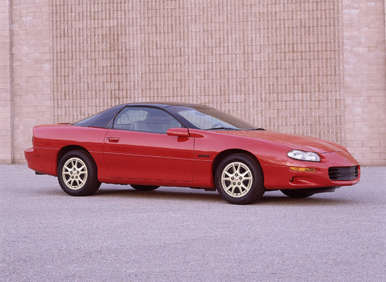
Chevrolet Camaro Used Car Buying Guide: 2010 — Present (2012)
The 21st century Camaro reemerged at the end of the first decade of the 20th century to considerable acclaim. While its exterior and interior styling were definitely retro inspired, the engineering of its mechanical bits were state-of-the-art. With direct injection and an all-independent suspension system, the fifth generation Camaro was faster and handled way better than any Camaro before it.
Typically, a performance-oriented muscle car model like the Camaro will have a V6 engine, in addition to its acclaimed V8s, to make it accessible to a broader range of buyers. Often, a number of people will want the look, but not necessarily the performance or excessive fuel consumption. So while the V6 engine option generally does not provide exceptional performance, it does give pretenders the opportunity to drive a car that looks faster than it is.
However, with the new Camaro, the V6 engine produced 300 horsepower and 273 foot-pounds of torque right off the top. Additionally, many reviewers thought the V6 Camaro handled better than the V8 equipped models. Delivering horsepower nearly equivalent to the Camaro Z-28 model preceding it, the new V6 Camaro offered thoroughly satisfying performance.
The V8 option was a 426-horsepower, 6.2-liter V8, delivering 420 foot-pounds of torque when paired with the six-speed manual transmission. If the six-speed automatic transmission was ordered, the V8 made 400 horsepower and 410 foot-pounds of torque. It also featured cylinder deactivation to enhance fuel economy.
Chevrolet Camaro Used Car Buying Guide: 2010
The 2010 Chevrolet Camaro debuted in coupe form only and was available in five trim levels; LS, 1LT, 2LT, 1SS, and 2SS. The former three came equipped with the V6 engine; the two latter models featured the V8.
As standard equipment, the base LS Camaro rode on 18-inch steel wheels. Key features included traction control, stability control, cloth upholstery, front bucket seats with power reclining seat backs, keyless entry, a tilt and telescoping steering wheel, air conditioning, cruise control, satellite radio, and a CD/MP3 capable audio system with satellite radio and an auxiliary audio input jack.
To this set up, the 1LT added fog lamps, 18-inch alloy wheels, and a six-way power actuated drivers seat. The 2LT model added 19-inch wheels, heated side mirrors, an electrochromatic auto dimming function for the driver side and interior mirrors, and a set of auxiliary gauges on the center console. The power-operated front seats were heated. The 2LT also featured remote engine start with the automatic transmission; in addition to a Boston acoustics sound system, a USB audio interface, and Bluetooth.
The 1SS models were focused primarily around the V8 engine. Feature-wise they were equipped similarly to the 1LT model, however, they used 20-inch wheels, high-performance brakes, and specific SS exterior and interior styling cues. The 2SS Camaro combined the powerful V8 with the luxuries of the 2LT.
Available Camaro option packages included the Convenience and Connectivity package; this fitted the 1LT Camaro with Bluetooth, steering wheel audio controls, a USB port, leather for the steering wheel and shift knob, remote start, and a cargo net. The RS package added Xenon headlights, as well as 20-inch aluminum wheels and a tail spoiler.
A sunroof was available as option for all Camaro models except the LS.
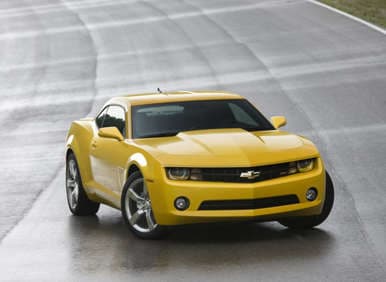
Chevrolet Camaro Used Car Buying Guide: 2011
The 2011 Chevrolet Camaro came with OnStar as standard equipment. The V6 engine was upgraded to produce 312 horsepower, and a heads up display was installed in the 2LT and 2SS Camaro models. The big news for 2011 however, was the debut of the all-new Chevrolet Camaro convertible. Featuring a power-operated folding soft top, the 2011 Camaro convertible was offered in all trim levels, except LS. Rear park assist was standar equipment for convertible Camaros.
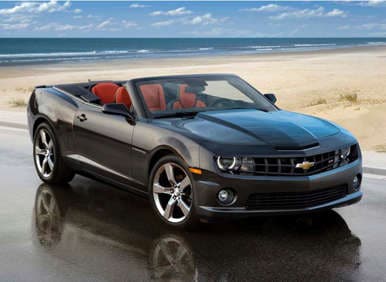
Chevrolet Camaro Used Car Buying Guide: 2012 (Current Model)
The big news for 2012 is the supercharged Camaro ZL1. Packing a 580 horsepower, 6.2-liter V8 with 556 foot-pounds of torque, the Camaro ZL1 is the fastest production Camaro ever offered. A six-speed manual transmission is standard, a six-speed automatic is optional—naturally, the engine's output is routed to the rear wheels.
In other developments for 2012, the 3.6-liter V6 now produces 323 horsepower and 278 foot-pounds of torque. Model year 2012 also represents the 45th anniversary of the launch of the Camaro back in 1967. To commemorate this, there is a 45th Anniversary package for 2LT and 2SS Camaros, consisting of a unique set of 20-inch wheels, black leather upholstery with accent stitching, and of course no anniversary package is complete without anniversary badges and logos.
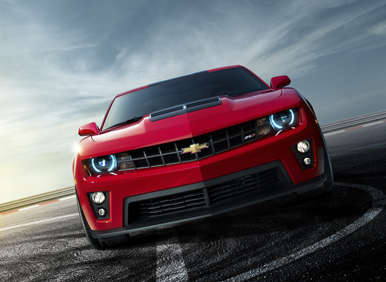
Chevrolet Camaro Used Car Buying Guide: Summary
Intricately intertwined in the American experience, the Chevrolet Camaro is an icon of the USA. Fast, powerful, and good looking, the Chevrolet Camaro scratches the itch of nearly every automotive enthusiast. With its broad variety of engines and equipment, it can also serve well as a daily driver for nearly everyone.
There are however, some considerations—particularly in the fifth-generation car. That low and sleek profile necessitates very small window areas, thus outward visibility can be compromised at times. Also, a number of reviewers have complained about the overall size of the fifth-generation Camaro.
Also, throughout the lifetime of the Camaro, its interior treatments have been criticized for their less than sumptuous appearance. And, while we lauded the attention paid to calling upon the history of the car in terms of its interior and exterior styling treatments, we strongly question the placementof the auxiliary gauges at the leading edge of the console—beneath the dash. This placement renders them all but unusable when the car is underway.
Still, there is much to love about the Chevrolet Camaro—not the least of which is its performance per dollar value. It's very difficult to find a car that performs as well as the Camaro does for equal or less money. That said, if you're shopping for a pre-owned Camaro you should keep in mind these are primarily performance cars and so therefore the probability of them having been used hard is great.
For this reason, a pre-purchase inspection by a trusted professional mechanic is of the utmost importance. Similarly, running a vehicle history report is also a very good idea. Popular cars like these are frequently stolen; you want to make sure the car you are buying has a clean title.
Another thing to keep in mind is the elevated cost of insuring a high-performance car like the Camaro. You'll want to get insurance quotes to make sure your situation will entitle you to a reasonable premium. The last thing you want to do is buy the car and learn you can't afford the insurance afterwards in fact.
There have also been a number of recalls for Chevrolet’s muscle car. Running an Internet search for “Chevrolet Camaro recalls” will help you determine which, if any, apply specifically to the model of your interest.
